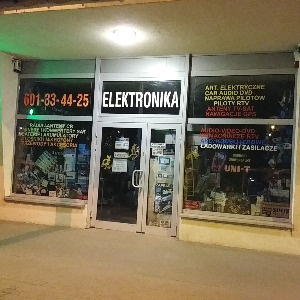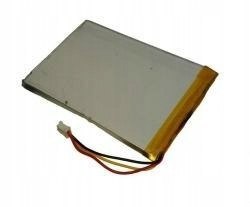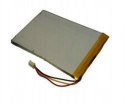
-
-
Koszyk jest pustyRealizuj zamówienieSuma 0
-
BATERIA Litowa Li-POLY 3,7V 520mAh 3 PRZEWODY










| Wysyłka w ciągu | w ciągu kilku dni kurierem DPD |
| Cena przesyłki | 24 |
| Dostępność |
|
Zamówienie telefoniczne : 601 33 44 25
| Zostaw telefon |
Przedmiotem aukcji jest akumulator / bateria Li-Poly o napięciu 3,7V .
Podana cena dotyczy jednej sztuki .
Cena za 1 szt.
Napięcie nominalne : 3,7V
UWAGA !
BATERIA FABRYCZNIE jest z 3 PRZEWODAMI .
Pojemność : 520mAh 0,52 Ah
WYMIARY ok. : Długość x Szerokość x Grubość - [mm]
58mm x 35mm x 3mm
Podłączenie fabryczne na 3 przewody.
Istnieje możliwość wykorzystanie tej baterii jako 2 przewodowej.
Wówczas wyjście czujnika termistorowego nie będzie podłączone i wykorzystane ( patrz schemat na foto 2 ) .
Akumulator posiada wewnętrzny elektroniczny układ zabezpieczający PCM ( pomarańczowa folia)
Foto 1 przedstawia przykładowa sprzedawaną baterię - foto poglądowe.
W zależności od dostaw sprzedawana bateria może się jednak różnić kolorem , brakiem lub obecnością napisów , marką ,oznaczeniami producenta , wtyczką wyjściową , przewodami , znakowaniem , kodem producenta , itp.
Foto 2 przedstawia rysunek poglądowy przykładowej baterii oraz przykładowy schemat bloku zabezpieczenia PCM - dla wtajemniczonych i zaawansowanych elektroników.
Foto 3 przedstawia inne przykładowe baterie tego typu ,dostępne na innych moich aukcjach Allegro.
PRZYKŁADOWE ZASTOSOWANIE:
Akumulatorki tego typu (mniejsze) znajdują zastosowanie w zabawkach , odtwarzaczach MP3 , mini kamerach ,dyktafonach , długopisowych urządzeniach , mini urządzeniach szpiegowskich , itp. Większej pojemności w nawigacjach , tabletach , sprzęcie radiokomunikacyjnym , geodezyjnym , nianiach elektronicznych , odtwarzaczach DVD , playerach , RTV , przenośnych TV , itp.
NA INNEJ MOJEJ AUKCJI KUPISZ INNE TEGO TYPU AKUMULATORKI / BATERIE.Również 2 przewodowe.
UWAGA ! ! !
Przewody baterii zakończone są wtyczką ( 3 pinową ) . Proszę jednak pamiętać że w różnych urządzeniach stosowane są różne wtyczki ( wszystkie są małe i podobne do siebie ) lecz nie zawsze pasują jedna za drugą.
Dodatkowym utrudnieniem jest kolejność przewodów we wtyczce i ich różna dla różnych producentów kolorystyka.
Jeśli nie jesteś pewien że podłączasz baterię w sposób prawidłowy , to jej NIE PODŁĄCZAJ lecz suj się z producentem urządzenia lub właściwym serwisem dla danego urządzenia.
UWAGA! Niewłaściwe podłączenie baterii do urządzenia lub ładowarki a także nie właściwe ustawienie parametrów ładowania ,może spowodować uszkodzenie zarówno baterii jak i urządzenia / ładowarki .Takie zdarzenie nie może być pokryte przez gwarancję , która obejmuje tylko sprzedawaną baterię w przypadku jej prawidłowego i zgodnego ze specyfikacją użytkowania.
Pod żadnym pozorem nie wolno naruszać delikatnej obudowy ogniwa ( nie przekłuwać , nie nacinać ,nie zaginać , nie wciskać na siłę do sprzętu , itp.)
UWAGA! ! ! Niewłaściwe użytkowanie / ładowanie baterii może doprowadzić do groźnego w skutkach pożaru.
: “ “
: "" / .
ZOBACZ INNE MOJE AUKCJE ()
,.
DODATKOWE POGLĄDOWE INFORMACJE tego typu i podobnych baterii (nie sprzedawanej na tej aukcji).
This specification describes the definition, technical requirement, testing method, warning and caution of the Lithium ion polymer rechargeable battery. The specification only applies to DUBILIER’S Li-ion battery.
2. Product Model
Battery type: Rechargeable Lithium-ion Polymer Battery 3. Ratings 3.1. Nominal Capacity[at 0.2C]: 1050mAh (min );
1100mAh (typical )
3.2. Nominal Voltage: 3.7V (average voltage at 0.2C discharge)
3.3. Charging Voltage: 4.20 ±0.05V
3.4. Max. Charging Current: 1050mA
3.5. Charging Method: constant current constant voltage Standard Charge: 525mA (constant current) charge to 4.20V, then 4.2V
(constant voltage) for 3.5hr or 21mA(0.02C) cut off
Quick Charge: 1050mA(constant current) charge to 4.20V, then 4.2V
(constant voltage) for 3.0hr or 21mA (0.02C) cut off
3.6. Max. Continuous Discharge Current: 2100mA
3.7. Discharge Cut-off Voltage: 2.75V
3.8. Battery Dimensions (Refer to the attached drawing)
Thickness: 4.8±0.2
(Measured with weighing 300gf at 25±2)
Width: 35±1
(Measured with weighing 300gf at 25±2)
Length: 63±1
3.9.Battery Weight: 23±1g
3.10. Operating Temperature
Discharge: -20 ~ +60
Charging: 0 ~ +45
Storage in a 50% charged state
Temperature range Duration Typ. Capacity recovery
-20 - +80 10 days 50%(expected)
-20 - +60 1month 75%(expected)
-20 - +45 3months 70%(expected)
-20 - +25 1year 80%(expected)
4. Battery Performance
4.1. Visual Inspection
There shall be no such defects as remarkable scratches, cracks, leakage or deformations.
4.2. Test Condition
4.2.1.Standard Test Condition
Test new cells within one month after shipment from our factory and the cells shall not be
cycled over five times before the tests.
All the tests in this specification shall be conducted in an ambient temperature of 25
±5 under a humidity of 25% to 85%, unless otherwise specified.
4.2.2 Measuring Instrument or Apparatus
4.2.2.1. The dimension measurement shall be implemented by instruments with equal or more
precision of 0.01mm.
4.2.2.2 Standard class specified in the national standard or more sensitive class having inner
impedance more than 10k/V.
4.2.2.3 Impedance shall be measured by a sinusoidal alternating current method (1kHz LCR
meter).
4.2.2.4 The current measurement shall be implemented by instrument with equal to more
precision scale of±0.1% and the constant voltage precision should be implemented
with±0.5%, and the timing precision should be not below ±0.1%.
4.2.2.5 The temperature measurement shall be implemented by instrument with equal or more
precision seal of ±0.5.
4.3 Electrical Characteristics
4.3.1 Standard Charge
The cell shall be charged at a constant current of 0.5C to 4.2V and then at constant
voltage of 4.2V with a charging time of 3.5 hours or 0.02C cut off.
4.3.2 Rated Capacity (0.2C): 1050mAh (minimum)
The capacity shall be measured at a discharge current of 0.2C and a cut-off voltage
of 2.75V after the standard charge (Section 4.3.1.)
4.3.3 High Rate Discharge Capacity (1C): 85% (minimum) of Rated Capacity
The capacity shall be measured at a discharge current of 1C and a cut-off voltage
of 2.75V after the standard charge (Section 4.3.1.)
4.3.4 Low Temperature Discharge Capacity (0): 80% (minimum) of Rated Capacity
The capacity shall be measured at a discharge current of 0.2C in an ambient temperature
of 0±2 and a cut-off voltage of 2.75V after the standard charge (Section 4.3.1.)
4.3.5 Low Temperature Discharge Capacity (-10): 70% (minimum) of Rated Capacity
The capacity shall be measured at a discharge current of 0.2C in an ambient temperature
of -10±2 and a cut-off voltage of 2.75V after the standard charge (Section 4.3.1.)
4.3.6 High Temperature Discharge Capacity (60): 100% (minimum) of Rated Capacity
The capacity shall be measured at a discharge current of 0.2C in an ambient temperature
of 60±2 and a cut-off voltage of 2.75V after the standard charge (Section 4.3.1.)
4.3.7. Storage Characteristics (25)
Capacity Retention: 85% (minimum) of Rated Capacity
Capacity Recovery: 90% (minimum) of Rated Capacity
The capacity retention shall be measured at a discharge current of 0.2C and a cut-off
voltage of 2.75V after standard charge (Section 4.3.1.) and being stored for 28 days
at 25±5. Then, the capacity recovery shall be measured at a discharge current of
0.2C and a cut-off voltage of 2.75V after standard charge (Section 4.3.1.).
4.3.8. Storage Characteristics (45)
Capacity Retention: 60% (minimum) of Rated Capacity
Capacity Recovery: 70% (minimum) of Rated Capacity
The capacity retention shall be measured at a discharge current of 0.2C and a cut-off
voltage of 2.75V after standard charge (Section 4.3.1.) and being stored for 28 days at
45±5. Then, the capacity recovery shall be measured at a discharge current
Of 0.2C and a cut-off voltage of 2.75V after standard charge (Section 4.3.1.)
4.3.9 Internal Impedance: 95m( type) ; 130m( max)
The internal impedance shall be measured at a since wave alternative current process of
1kHz after the standard charge.
4.3.10. Cycle Life :
The cycle life shall be conducted as the following procedures:
Step 1: charge the cell with the standard charge (as of section 4.3.1);
Step 2: discharge the cell at 0.5C to 2.75V,
Step 3: repeat Step 1 and Step 2 for 500 times.
The capacity after 300 cycles is expected to be equal to or more than 80% of the rated
capacity. The capacity after 500 cycles is expected to be equal to or more than 60% of the
rated capacity.
4.3.11 Open Circuit Voltage: 3.6V ~ 4.1V as of shipment.
4.4 Mechanical Performance
4.4.1 Vibration Test: 95% (min) of Rated Capacity, No Leakage
After standard charge (Section 4.3.1.), the battery is vibrated with an amplitude of 0.8mm
(1. 6mm total maximum excursion) for 60 minutes in three mutually perpendicular
directions. The vibration is performed between 10Hz and 55Hz at a rate of 1Hz per minute
After the completion of the vibration, the capacity shall be measured at a discharge current
of 0.2C and a cut-off voltage of 2.75V
4.5 Environmental Performance
4.5.1 Thermal Shock Test: No Leakage, No Fire, No Explosion
The battery is stored at 75±5 for 48 hours, moved to a temperature of -20±5
within 5 minutes and stored for 6 hours after standard charge (Section 4.3.1.).
4.6 Safety Performance
4.6.1 Short Circuit Test: No Fire, No Explosion
After standard charge (Section 4.3.1.), the battery shall be subjected to a short-circuit
condition with a wire of resistance less than50mfor 1 hour.
4.6.2 Overcharge Test: (with a PCM) No Fire, No Explosion
After standard charge (Section 4.3.1.), the battery shall be charged at 1C /12V
For 2.5 hrs.
4.6.3 Thermal Exposure Test No Fire, No Explosion
After standard charge (Section 4.3.1.), the battery is placed in an oven and is heated up at a
rate of 5 until the temperature reaches 130. The oven shall be maintained at 130 for 60 minutes.
5. Delivery Condition: about 50% charged.
6. Lithium Ion Polymer Battery Handling Guideline
6.1 In case of contacting the materials from a damaged or ruptured cell or battery:
Eye contact: Washing immediately with plenty of water and soap or for at least 15 minutes.
Get medical attention.
Skin Contact: Washing immediately with water and soap. Inhalation of Vented Gas:
Remove to fresh air. Get medical attention. Ingestion: Get medical
attention immediately.
6.2 Keep away batteries from children.
6.3 The cells/ batteries are requested to be stored within a proper temperature range specified in
this specification.
6.4 Do not store batteries in a manner that allow s terminals to short circuit.
6.5 Do not place batteries near heating sources, nor exposed to direct sunlight for long periods.
Eleed temperatures can result in reduced battery service life.
6.6 Charging Battery
Use only approved chargers and procedures. Improperly charging a cell or battery may cause
the cell or battery to flame or damage.
Charge the battery using the “CC/CV” or constant current /constant voltage method.
Do not charge the battery with a current or voltage higher than the specified maximum value in this specification. The absolute maximum charging voltage is 4.25V per cell.
Prohibit reverse charging of the battery. The battery must be connected correctly.
6.7 Discharging Battery
Discharge battery at the max current specified in this specification. If you plan to discharge
battery at a higher current than the max current, please consult us.
Avoid discharge the battery below 2.75V for each cell.
Do not over-discharge the battery. Over-discharging can damage the performance of the
battery. It should be noted that the cell/battery would be at an over-discharged state by its
self-discharge characteristics in case the cell is not used for long time. In order to prevent
over-discharging, the cell/battery shall be charged periodically to maintain between 3.7V and
4.1V.
6.8 Operation Temperature
The battery shall be operated (stored, charged and discharged) in the temperature specified in
This specification.
6.9 Cell/Battery Protection Circuit Module (PCM)
The cell/battery must be equipped with a PCM that protects the cell/battery from
overcharging, over-discharging and over-current.
6.10 Battery Short Circuit
Do not short-circuit a battery. A short circuit can result in over-heating of the terminals and
provide an ignition source. More than a momentary short circuit will generally reduce the
cell or battery service life and can lead to ignition of surrounding materials or materials
within the cell or battery if the seal integrity is damaged. Extended short-circuiting creates
high temperature in the cell and at the terminals. Physical contact to high temperatures can
cause skin burns. In addition, extended short-circuit may cause the cell or battery to flame.
6.11 Prohibit reversing cell polarity within a battery assembly.
6.12 The cell edge of the heat seal zone is electrically conductive. Avoid the edge cross battery
terminals, PCB, or conductive surfaces.
6.13 Do not bend, fold or fall the battery or part of the battery. It may cause the battery be
damaged and result in the battery swelling, leaking, explosion or ignition
6.14 Do not open or manipulate the folded cell edge.
6.15 Do not bend or fold the sealing edge. And do not tear off the sealing film.
6.16 Battery Pack Design
The battery housing should have sufficient mechanical strength.
No sharp edge components shall be inside the battery housing. The sharp edge may destroy
the cell packaging.
No cell movement is allowed in the battery housing.
The ultrasonic head shall not directly/ or indirectly pressed the cell if you need to enclose
the battery housing by ultrasonic method. Please consult us for designing the ultrasonic
head. Avoid designing airtight battery housing.
6.17 Battery Assembly
We recommend ultrasonic welding or spot welding to connect battery with PCM or other
parts. If you employ manual solder method to connect tab with PCM, please pay attention to
the followings:
Use a solder with temperature controlled and ESD.
Soldering temperature should not exceed 300.
Soldering time should not be longer than 3s.
Soldering times should not exceed 5 times.
Keep battery tab cold down before next time soldering.
Do not directly heat cell body. It may cause the battery be damaged by heat above 90
6.18 Battery Disassembly
Never disassemble a battery.
Should a battery unintentionally be crushed, thus releasing its contents, rubber gloves must
be used to handle all battery components. Avoid inhalation of any vapors that may be
emitted.
6.19 Do not mixed Batteries and Types. Avoid to use old and new cells or cells of different sizes,
different chemistry or types in the same battery assembly.
6.20 Other Warnings
Do not heat or dispose the battery into fire, water or other liquids.
Do not put the battery into microwave, washing machine or drying machine.
Do not use a damaged battery.
" "
"" / , ().
Wystawiono z oprogramowania

| Stan | Nowy |
| Kod producenta | 0602016C1 |
| Marka | GP |
| Liczba baterii | 1 |
| Pojemność | 90 |
| Symbol baterii | CR2016 |
| Technologia wykonania | litowa |
| Napięcie | 3 |
- Producenci






